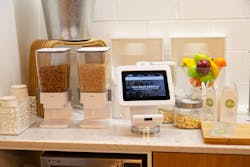Innovation can come in the most unlikely places. It can come as operators discover an opportunity to use countertop kiosks in pantry service to provide more efficiency and transparent reporting. It’s a blending of systems that can deliver superior results.
Pantry service defined
Let’s begin by defining a typical pantry service model. It includes placing food, snacks and beverages in a break room, monitoring what has been consumed, reporting to the location’s decision maker what has been consumed (billing), keeping track of the budget per employee as the month progresses to avoid going over budget, procuring new products to suggest to the location, tracking those sales, etc. There is a great amount of manual labor involved, from the route driver who inventories items and restocks the pantry to the customer liaison at the operation who works directly with the decision maker on budgets, requests and billing. Cutting out some of that labor and utilizing product analysis and prekitting tools in an operation’s existing MMS can make pantry service a more efficient solution.
Technology makes it easier
Instead of the route driver inventorying all the items in the break room to determine what has been consumed, that data is captured at the kiosk. Employees are asked to scan the items so that the service company knows what to bring with them during the next service. While the scanning does provide this information, the data can be used in multiple ways to create a more efficient service.
- Prekitting: The information can be used by the micro market management system (MMS) or warehouse system to create a prekit list for that location. Previously the driver would have to guess what would be needed, use predictive analysis software or carry around extra inventory to restock the pantry.
- Clean data: Because what employees are consuming is captured automatically, it eliminates the errors inherent in manual data entry. This data is no longer at risk of being missed because it isn’t part of the main data collection system, because its integrated right into the MMS.
- Product trends: The scanned information is easily segmented to see trends, such as the rise in consumption of a new item, and if those sales begin to decline. The data can be cut into high cost and lower cost items as well, so the location is better able to maximize the budget it allots per employee.
- Transparent reporting: When a location receives a bill for products consumed, the decision maker must trust the accuracy of the number provided by the employer, resulting in questions about how its inventoried, tallied, tracked, etc. With a kiosk collecting this information, there is more transparency to the process, helping the decision maker see exactly what the employees are opting for in the breakroom and how that information is collected and reported.
- Lowering pilferage: The very act of scanning items in the break area will reduce the likelihood that employees will grab handfuls of products to take home, which can sometimes be a problem with traditional pantry service. Adding cameras to the pantry area will enhance this feature and can be used in case there is ever a problem of matching inventory to the sales reported by the kiosk. (Note: The agreement between the service provider and the location should include a percentage for shrinkage as no system is perfect, and also a limit to that shrinkage when service needs to be reassessed.)
- Digital communication: A further advantage to utilizing a kiosk is the ability for the company to provide employees messages, from upcoming events, corporate mottos, work anniversaries announcements, wellness initiatives and much more.
Pantry service is a lucrative service for many operators. Its popularity is being driven by the dropping unemployment rate and competitive employers who realize it takes extra benefits to attract talented employees and retain the top performers they already have. For many in this position, those extra benefits are manifesting as free food and beverages in the break room or pantry area stocked by an employee who has other full-time responsibilities. As the company grows, keeping the pantry area stocked becomes too time-consuming and hiring a dedicated full-time employee for the space is expensive. This is where service providers are successful in providing pantry service. By using existing technology to manage the inventory automatically, it can be a very competitive solution.






